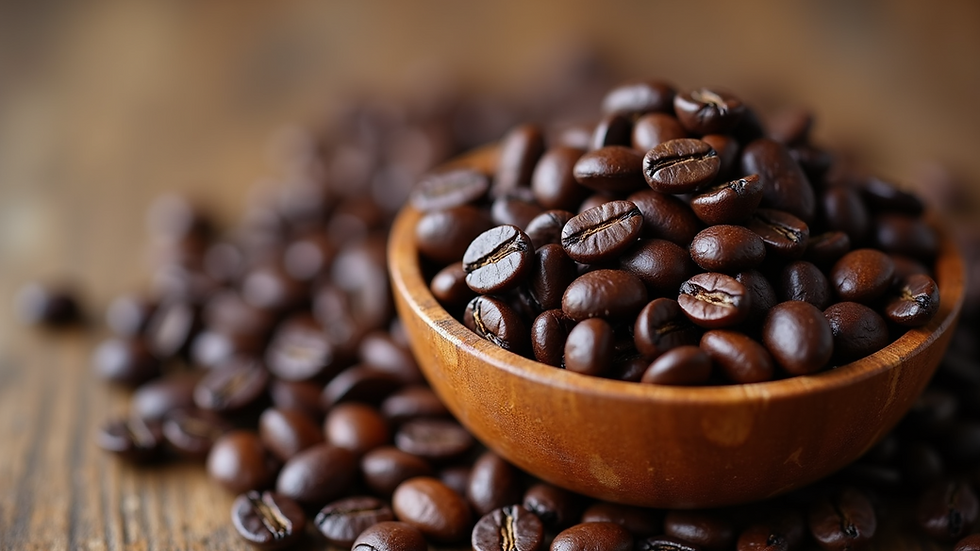What Makes High-Quality Coffee Beans Unique?
- Wilmot Forester

- Aug 19
- 4 min read
Coffee lovers around the world appreciate the rich flavors and aromas that come from high-quality coffee beans. But what exactly sets these beans apart from the ordinary ones found in most grocery stores? The journey from seed to cup involves many factors that influence the final taste and experience. Understanding these elements can help you make better choices and enjoy your coffee even more.
The Characteristics of High-Quality Coffee
High-quality coffee beans are distinguished by several key characteristics that affect their flavor, aroma, and overall quality. These include:
Origin and Variety: The region where coffee is grown plays a crucial role. Factors like altitude, soil type, and climate create unique growing conditions. For example, beans from Ethiopia often have fruity and floral notes, while those from Brazil tend to be nutty and chocolatey.
Bean Size and Shape: Uniformity in size and shape indicates careful sorting and selection. Larger beans often have more complex flavors.
Processing Method: How the beans are processed after harvesting—washed, natural, or honey processed—affects the taste profile. Washed beans tend to be cleaner and brighter, while natural processed beans have more body and fruity flavors.
Freshness: Freshly roasted beans retain more of their natural oils and flavors. Coffee starts to lose its aroma and taste soon after roasting, so buying fresh beans is essential.
Roast Level: The roast profile can highlight or mask certain flavors. Light roasts preserve the bean’s original characteristics, while darker roasts bring out deeper, roasted notes.
By paying attention to these factors, you can identify coffee beans that promise a superior cup.

How to Identify High-Quality Coffee Beans
When shopping for coffee, it’s essential to know what to look for to ensure you’re getting the best beans possible. Here are some practical tips:
Check the Origin: Look for beans that specify their country and region of origin. Specialty coffee shops often provide detailed information.
Look for Specialty Grade: Specialty coffee is graded based on quality and defects. Beans with a score above 80 are considered specialty grade.
Inspect the Packaging Date: Freshness matters. Choose beans with a recent roast date, ideally within the last two weeks.
Smell the Beans: If possible, smell the beans before buying. High-quality beans have a strong, pleasant aroma.
Avoid Pre-Ground Coffee: Whole beans retain freshness longer. Grind your coffee just before brewing for the best flavor.
By following these guidelines, you can confidently select beans that will deliver a rich and satisfying coffee experience.

Why is Blue Mountain Coffee So Expensive?
One of the most famous and sought-after coffee varieties is the Blue Mountain Coffee bean. Grown in the Blue Mountains of Jamaica, this coffee is renowned for its smooth, mild flavor and lack of bitterness. But why does it command such a high price?
Limited Growing Area: The Blue Mountains cover a small region with ideal conditions for coffee cultivation. The limited supply drives up the price.
Labor-Intensive Cultivation: The steep terrain requires hand-picking and careful processing, increasing production costs.
Strict Quality Control: Only beans that meet rigorous standards can be labeled as Blue Mountain coffee.
High Demand Worldwide: Its reputation for exceptional quality makes it highly sought after by coffee connoisseurs.
These factors combine to make Blue Mountain coffee a premium product worth the investment for those who appreciate fine coffee.

The Impact of Growing Conditions on Coffee Quality
The environment where coffee is grown has a profound effect on the beans’ quality. Several elements contribute to this:
Altitude: Higher elevations produce denser beans with more complex flavors. Coffee grown above 3,000 feet is often considered superior.
Climate: Consistent temperatures, adequate rainfall, and humidity levels influence bean development.
Soil Composition: Nutrient-rich volcanic soils, for example, enhance the flavor profile.
Shade and Sunlight: Shade-grown coffee tends to mature more slowly, resulting in better flavor complexity.
Farmers who understand and optimize these conditions can produce beans that stand out in taste and aroma.
How to Brew the Best Cup from High-Quality Beans
Even the best beans need proper brewing to unlock their full potential. Here are some actionable recommendations:
Use Freshly Ground Beans: Grind just before brewing to preserve flavor.
Measure Coffee and Water: A general guideline is 1 to 2 tablespoons of coffee per 6 ounces of water.
Use Clean, Filtered Water: Water quality affects taste.
Control Water Temperature: Ideal brewing temperature is between 195°F and 205°F.
Choose the Right Brewing Method: Different methods highlight different flavors. For example, pour-over emphasizes clarity, while French press offers a fuller body.
Experimenting with these variables can help you find the perfect cup tailored to your taste.
Exploring the world of high-quality coffee beans reveals a fascinating blend of nature, science, and craftsmanship. From the unique growing conditions to the meticulous processing and brewing techniques, every step influences the final cup. Whether you are drawn to the exclusive Jamaica Blue Mountain Coffee bean or other specialty varieties, understanding what makes these beans unique will enhance your appreciation and enjoyment of coffee.



Comments